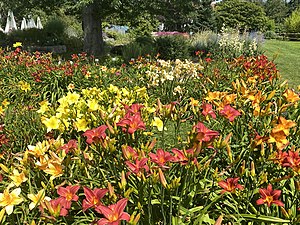
In a world increasingly impacted by warming, and with more people living in peri-urban areas amid natural settings, bushfire or wildfire hazards are a reality for many homeowners, farmers, lifestyle block owners and others. There are many things you can do to decrease the susceptibility of your living areas to fire damage and one of the things you can do is choose plants that are resistant to fire.
Using firewise or fire resistant plants in the areas around your home, garage, sheds, tanks, barns, fields, etc., can make a difference as to whether or not a fire takes hold on your property or causes severe damage.
Be aware that what is appropriate defensible space and which plants are appropriate will change depending on where you live in the world and the known ferocity of fire fronts in your area. With climate change impacts increasing, it pays to continuously update your knowledge and awareness of what to expect in changing environmental conditions.
Defensible space[edit | edit source]
Consider where not to plant first. This means planting minimum vegetation right next to walls to about 15 to 30 feet from the walls.[1][2] The reason behind this is to allow a space for firefighters to be able to get near the property and defend it.[1]Develop a fire ladder, which consists of different heights of vegetation.[2]Place the low plants near your house, and the tallest plants as far from the wall or away from built structures as possible.
Ensure that there are no branches within 10 feet of the roof or the side of the house.[2]Keep a break between ground fuel plants and the lowest limbs of trees.[2]This makes it harder for a fire to climb from ground fuel plants onto trees and potentially onto built structures. Do not plant shrubs under trees.
Reducing problems caused by plants[edit | edit source]
- When plants die down and leave brown, dead vegetation, remove it immediately.
- Leaves with small leaves are a good choice, as the plant has little to feed off.[1]
- Sprawling ground cover plants can be useful to stop weeds from growing and therefore reduce the potential for dried weeds, which can be a fire hazard.[1]
- Prune and maintain plants well.[1]Remove all dead wood quickly, especially during dry seasons.
- Plant in little pockets rather than in large sprawls of plantings.[1]
- Keep plants green and supple, all the way to the base of the plant.[2]
- Use pebbles rather than straw, tanbark or other organic matter in garden beds situated next to or close to the house.
- Regularly collect up dead, loose or broken plant matter, branches, twigs, leaves, etc., that can act as fire fuel.
- Keep long grass around the house cut short.
- Do not keep dense scrub near housing or buildings.
- Cut dead vines and trailing plants off structures. Unless the vine is especially succulent, consider removing it altogether.
- Plant the vegetable garden on the side of the house that is at greater risk from bushfire or wildfire.
- Avoid using plant matter for fencing material close to the house. This includes wood.
- Clean leaf litter out of gutters regularly.
Where possible, it's great to choose plants that don't need a lot of water as well as being fire resistant. However, all plants need sufficient watering, as any plant that dries out can become a fire hazard.
Plants with fire resistant properties[edit | edit source]
- Delphinium (tall, so keep out of the defensible space)
- Iris
- Daylilies
- Yarrow
- Wild geranium
- Lavender
- Thyme
- Succulents - plants that store water
- Low shrubs without oily leaves
- Rainforest evergreens
- Edible trees
- Native plants that have been assessed as suitable by your local forestry/bushfire/wildfire agencies
Plants to avoid near buildings[edit | edit source]
Plants that burn fiercely should not be planted near buildings or structures. These include:
- Juniper[2]
- Cedar hedges[2]
- Plants with high oil levels (for example, eucalyptus trees)
- Plants that collect dead weeds or dry leaf matter[2]
Suggestions for reading[edit | edit source]
- Fire-Resistant Plants for Home Landscapes (an Oregon publication),[2] also see oregon.gov/odf for pdf copies
- Fire retardant garden plants, by the Tasmanian Fire Service, at https://www.fire.tas.gov.au/publications/1709%20Brochure.pdf (groups plants by flammability levels)
- Landscaping for bushfire: Garden design and plant selection, by the CFA, Victoria, at http://web.archive.org/web/20180313054932/http://www.cfa.vic.gov.au/fm_files/attachments/plan_and_prepare/landscaping/landscaping_for_bushfire.pdf
- A Flammability Guide for Some Common New Zealand Native Tree and Shrub Species, by Liam Fogarty, at http://www.fire.org.nz/research/Published-Reports/Documents/89fa12a030b48531cf396dcdba52c6e2.pdf
External Links[edit | edit source]
Fire Wise Landscaping-Permies.com
Sources and citations[edit | edit source]
- Tagawa Gardens, Fire resistant plants, https://www.youtube.com/watch?v=JvwDLtcRkOg - source of some information on fire resistant plant types
- Oregon Department of Forestry, Fire resistant plants for landscaping, Wildfire Awareness Month, https://www.youtube.com/watch?v=jvMRdQb9ulY - source of some information on fire resistant plant types
- Firewise landscaping and plant lists, http://firewise.org/wildfire-preparedness/firewise-landscaping-and-plant-lists.aspx?sso=0